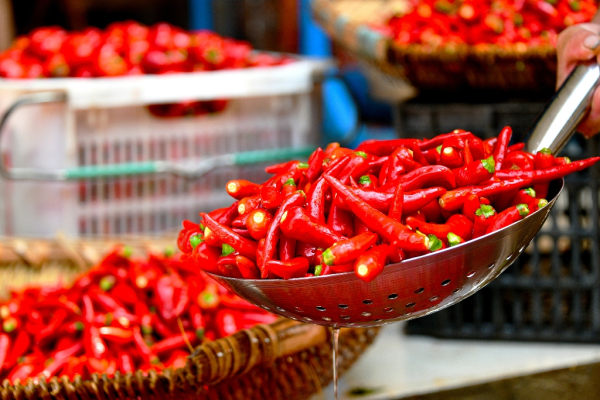KPL
Redhot peppers from China’s Guizhou Province are now thriving in the fields of Laos, thanks to a cross-border farming partnership that’s heating up more than just kitchens.
Guizhou, located in southwest China, provides premium seeds and know-how, while Luang Namtha in northwestern Laos offers 2,000 hectares of fertile land, ideal for year-round cultivation.

Fresh red peppers are being prepared for making smoky chili sauces in Guizhou in southwest China. [Photo: VCG]
By: Chen Ziqi, journalist with CGTN
(KPL) Redhot peppers from China’s Guizhou Province are now thriving in the fields of Laos, thanks to a cross-border farming partnership that’s heating up more than just kitchens.
Guizhou, located in southwest China, provides premium seeds and know-how, while Luang Namtha in northwestern Laos offers 2,000 hectares of fertile land, ideal for year-round cultivation.
This cross-border partnership means a steady supply of fresh peppers for China during the off-season, and great job opportunities in Laos. In 2024 alone, the project yielded around 150,000 tons of high-quality peppers, most of which were consumed by Chinese spice-lovers.
A flavor that lingers

Farmers in Guizhou harvest peppers, August 13, 2022. [Photo: VCG]
Guizhou Province is known for producing chili peppers that leave a rich, lingering flavor on the tongue. Locals proudly claim their peppers spice things up for the spices. Sauce makers often mix them in with other varieties to level everything up. Locals say that many hot sauces rely on Guizhou peppers as the secret ingredient that makes the sauce, bold enough to stand out, smooth enough to blend in.
While Sichuan may be China’s most famous spicy region, Guizhou was in fact the first to embrace chili peppers back in the late 16th century, via the Ancient Silk Road. Then, with its mild temperatures, abundant sunlight, ample humidity, and the rugged landscape that prevents plant diseases and pests, the region becomes a natural haven for chili cultivation.
By the end of 2024, Guizhou had become China’s top pepper producer, while the country accounted for nearly half of the global pepper production.
Centuries of tradition shape today’s flavor
With over 400 years of chili-eating tradition, generations in Guizhou have mastered the art of selecting pepper seeds that deliver the finest flavor and highest yields.Today, this tradition has developed into a scientific process, led by professional breeding teams.
According to TianHao, a local agricultural scientist, developing a new pepper variety can take several years, sometimes over a decade. The goal is to produce peppers that are resilient to floods and disease, but with healthy appearance and exceptional flavor. One such success is a variety called Zunjiao111, selected among more than 4,000 hybrid candidates,and gained widespread acclaim at the 2023 Guizhou Zunyi International Chili Expo.
Guizhou: China’s chili benchmark
With its vast cultivation area and consistently high-quality peppers, Guizhou has become the benchmark of China’s chili industry, setting the standard and influencing prices nationwide. To gauge how hot the chili market is, both literally and economically, look no further than China Chili City, a large-scale trading hub in Zunyi, southwest Guizhou. This mega-market has emerged as the beating heart of the nation’s chili trade.

Workers dry fresh peppers at the Zunyi Pepper City, August 27, 2022. [Photo: VCG]
The China Chili City was not built over night. Over the past six decades, the pepper economy in Guizhou has transformed from scattered, informal village-level trading into this highly organized and efficiently operated market system. It connects buyers and sellers from across China, and increasingly from abroad, with its online platform facilitating chili imports from countries such as India and Myanmar. During peak season, the market is blanketed in a sea of vibrant red chilies, piled so high and wide that the edges vanish from sight. The air is thick with pungent smell, so fiery it can make even seasoned traders sneeze.
From Guizhou to the globe
In 2024, the China Chili City recorded a transaction volume of 750,000 tons of peppers, with a trade value surpassing $1.4 billion. In 2023, chili peppers were exported to over 30 countries and regions from the trading hub, including the U.S., India, and several Southeast Asian nations, reaching a trade value of $93.2 million.
Guizhou’s chili peppers have been fueling a booming industry, blending centuries-old tradition with modern trade. This fiery crop powers a billion-dollar market, sustaining communities and shaping the future of global spice commerce, proving that great flavors can ignite more than just taste buds.
KPL